
By the time Homo sapiens arrived in Europe, Neanderthals had already made the continent their home and adopted behaviors and practices that were later associated with Sapiens.
It was the Neanderthals who invented an instrument called a lissoir (polishing) - one of the oldest tools located in Europe, which was made up of flexible pieces of deer ribs and was used to work hides, making them soft and resistant, being a tool (obviously adapted) used until today in tanneries. It is a specialized and sophisticated artifact that Neanderthals were fully capable of developing, associating the specific characteristics of the material with the possibilities of its uses and applications.

Parts of this type were located in southwestern France and date back about 50,000 years. Responsible for identifying the instrument, archaeologist Marie Soressi concludes that this finding confirms the fact that several creations and habits of Homo sapiens may have been reproduced from what Neanderthals were already doing, reinforcing the idea that the interaction between these species was intense. two species. The researcher said that “this is the first evident evidence of transmission of culture from Neanderthals to our direct ancestors…. It may be one or perhaps even the only legacy from Neanderthal times that our society is still using today.”
